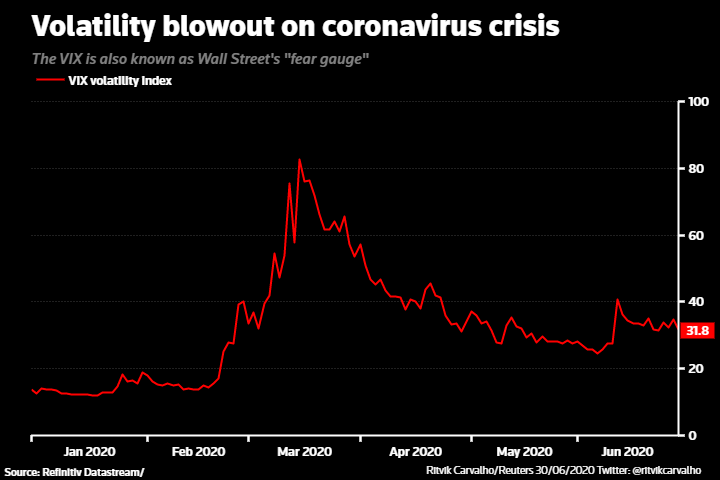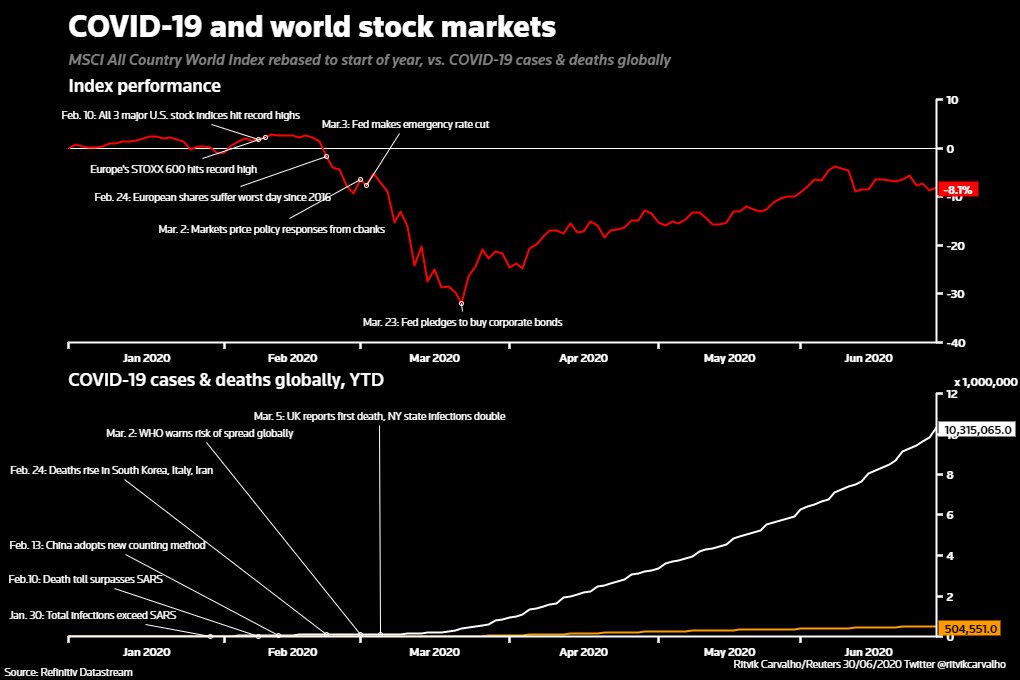By Ritvik Carvalho
From a January lockdown in a Chinese province to 10 million infections worldwide, the coronavirus' march across the globe has buffeted markets at every step these past six months, roiling the very plumbing of the global financial system.
Market panic and economic devastation from lockdowns elicited an unprecedented response from policymakers, sowing seeds of recovery.
The following charts aim to capture some of the milestones.
1)CHINA: WARNING SIGNS AND ACTION
On Jan. 21, there were reports of a "flu-like" virus in China and soon after the city of Wuhan closed urban transport and suspended outgoing flights.
By Jan. 27, the World Health Organisation declared an emergency in China, hitting the yuan and Chinese equities.
Graphic: COVID-19 and Chinese markets - 
On Feb. 3, China's central bank stepped up https://fingfx.thomsonreuters.com/gfx/editorcharts/xklpyzndovg/index.html with a $174 billion liquidity injection, the first of many such actions worldwide. On Feb. 17, it cut interest rates and infused more cash into the system.
In early April, Wuhan started to ease its lockdown.
Graphic: China central bank hoses markets with liquidity - 
2) MARKETS ABLAZE
On Feb. 10 , the WHO called the virus "a spark that becomes a bigger fire". But world stocks still hit record highs on Feb 19.
On Feb. 24, as deaths mounted in South Korea, Italy, and Iran, European shares suffered their worst day since 2016.
On March 9, the S&P500 posted its largest one-day drop since 2008 and 30-year Treasury yields fell below 1% for the first time ever.
The following week, Wall Street's VIX volatility gauge surged above 85, versus month-ago levels around 15.
Graphic: Volatility blowout on coronavirus crisis - 
World stocks hit 3-1/2 year lows on March 23 before recovery kicked in. On June 4, Nasdaq tech shares surpassed pre-COVID record highs.
Graphic: COVID-19 and world stock markets - 
3)"WHATEVER IT TAKES-2"
Market panic galvanised the Fed into an emergency interest rate hike on March 3.
Graphic: Speed, severity of coronavirus selloff - 
On March 11, the Bank of England slashed rates to 0.25%. The Fed went to 0% too in an unscheduled March 15 move, triggering more policy easings worldwide.
For an interactive version of the below chart on policy easings, click here  .
.
On March 19, the European Central Bank launched a 750 billion euro ($841 bln) emergency bond buying scheme.
On March 23, the U.S. Federal Reserve pledged to buy corporate bonds, including select junk securities, for the first time ever. U.S. corporate yields tumbled 80 bps in a week and are now at record lows.
Graphic: Yields tumble after Fed's corporate bond buy pledge - 
4) EUROPEAN U-TURNS
The crisis forced a U-turn on budget frugality, notably in Germany which on March 23 announced a spending package of up to 750 billion euros. Britain also reversed "austerity", with 133 billion pounds in pledges.
On May 18 came a proposal with potential to change euro area fortunes: a 750 billion euro European Union recovery fund, to be financed via joint debt issuance. The move, pivotal for European cohesion, has seen 10-year borrowing costs for euro zone weak link, Italy, tumble 50 bps.
Graphic: Euro, euro zone bond markets in the coronavirus crisis - 
5) DOLLAR CRUNCH
The March meltdown fuelled a dash for dollars, blowing out swap premia for the greenback. Euro-dollar three-month swap spreads surged above 120 bps on March 17, the widest since 2011. Between March 9-20, the dollar jumped 9%.
Graphic: Dollar stays king in coronavirus crisis - 
Strains eased after the Fed opened dollar swap lines with major central banks, later expanding the facility. In early June, the dollar had slipped to March 10 levels.
Graphic: Euro-dollar funding markets recover from stress - 
(Reporting by Ritvik Carvalho; Editing by Andrew Cawthorne)

 S&P 500
S&P 500 





